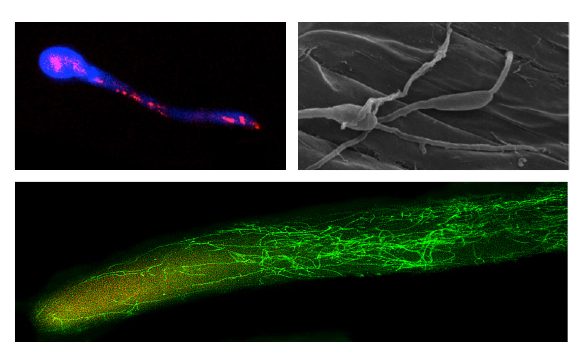 |
|
Signalling and pathogenesis in fungi
Responsible: Antonio Di Pietro |
Fungal pathogens use chemical and physical signals to sense nutrient status, surface contact and presence of the host. This information is processed by a network of conserved cellular pathways and leads to the activation of the genetic infection program. Among the key pathways are MAPK (Mitogen-Activated Protein Kinase) cascades, which are required for pathogenicity in a wide range of plant pathogenic fungi. Our group was the first to characterize a MAPK (named Fmk1 for Fusarium MAP Kinase 1) in a soilborne plant pathogen. F. oxysporum mutants lacking Fmk1 are deficient in root penetration and fail to cause disease on tomato plants. A major effort in our lab is directed towards understanding the function of the broadly conserved MAPK cascades in fungal pathogenicity. Previous work established that Fmk1 controls virulence-related processes such as adhesion to the plant surface, production of cell wall-degrading enzymes and invasive growth on living host tissue. |
|
 Chemotropism in F. oxysporum Chemotropism in F. oxysporum |
| The first response of a pathogen during infection is the perception of chemical stimuli from the plant that trigger directional hyphal growth (chemotropism). The mechanism underlying the chemotropic response in fungal pathogens is currently unknown. We found that F. oxysporum can sense and grow towards a variety of chemical stimuli such as nutrients, sex pheromones or plant compounds. Our goal is to characterize the host chemoattractants and their cognate receptors, as well as the cellular pathways that activate the chemotropic response in the fungus. This research is carried out within the Consortium "FUNGIBRAIN: Sensing and integration of signals governing cell polarity and tropism in fungi"of the 7th European Framework Program that joins 8 academic groups and 3 companies. |
|
| |
 pH control of MAPK signalling and pathogenicity pH control of MAPK signalling and pathogenicity |
| The infection process in F. oxysporum requires signalling by 3 distinct MAPKs, Fmk1, Mpk1 and Hog1. These pathways are regulated by environmental stimuli such as nutrients, pH or plant signals, which trigger rapid changes in MAPK phosphorylation patterns. Additional protein kinases such as TOR (target of rapamycin) also impinge on the expression of virulence functions. We use a combination of genetic and biochemical approaches to study how MAPK cascades are regulated during fungal infection by different environmental cues, particularly ambient pH. This research has been carried out within the Consortium"ARIADNE: Signaling circuitry controlling fungal virulence: identification and characterization of conserved and specific fungal virulence genes as common antifungal targets" of the 7th European Framework Program that joins 7 academic groups and 2 companies. |
|
| |
 Genetic mechanisms driving adaptation to the pathogenic lifestyle in fungi Genetic mechanisms driving adaptation to the pathogenic lifestyle in fungi |
| F. oxysporum causes disease both on plants and animals, being the only trans-kingdom infection model reported so far in fungi. Using forward and reverse genetics we identified a set of genes required for virulence on tomato and/or on immunodepressed mice and Galleria. We have evidence suggesting that certain genomic regions of F. oxysporum undergo frequent reorganizations, thereby promoting phenotypic variability and pathogenic adaptation. In collaboration with different laboratories we are investigating the genetic mechanisms responsible for these changes and their role in the evolution of new infectious forms of F. oxysporum. |
|
 |
|
|
| |
|
